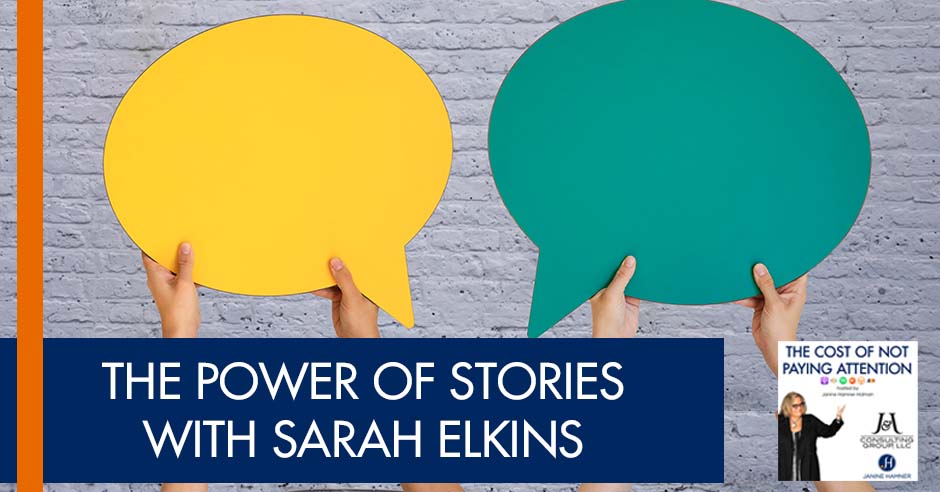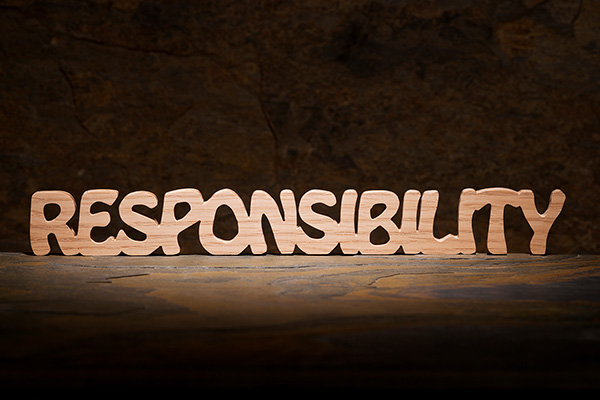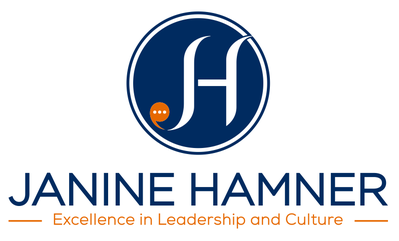
It’s amazing how the brain absorbs information through the stories that we tell and how the same story gets different receptions and reactions based on how it’s told. In this episode, Sarah Elkins talks about the cost of not paying attention to the power of stories. Word of mouth can spread quickly and before you realize it, you are reaping the benefits or paying the price for your values, how you do business, treat your employees, or the way you make other people feel. Listen and learn how you can improve the way you communicate to effectively demonstrate good values, build trust, and ultimately avoid negative interpretations of your actions.
GUEST: Sarah Elkins | Linkedin, Instagram | Visit their Website: http://elkinsconsulting.com | Podcast link: https://podcasts.apple.com/us/podcast/your-stories-dont-define-you-how-you-tell-them-will/id1329558957 | Book purchase: https://www.amazon.com/Your-Stories-Dont-Define-You/dp/1646631110/ref=tmm_pap_swatch_0 | Discovering Clarity course: https://sarah-elkins.mykajabi.com/offers/8RVXVkcf
HOST: Janine Hamner Holman | [email protected] | LinkedIn, Facebook, Instagram, and Twitter |
—
Listen to the podcast here
The Power of Stories with Sarah Elkins
What am I paying attention to? The power of stories. What I mean by that is the power of storytelling. When we tell a good story, it gets sticky in the brain of the listener because our brains are wired for a story. If you think about it, given we are an oral tribe, all of the stories from the past were an instrinstic part of our ancestors’ lives. Stories were told to help people stay alive. Stories were about things that were important. How things got passed down was through storytelling. Our brains have learned “hear a story, pay attention”. A story sticks in our brain differently than facts and figures.
When I first started working, I was trained as a community organizer. I was trained by Fred Ross Jr., the son of the person who trained Cesar Chavez, Fred Ross Sr. “Forget the facts and figures. Tell them the story that brought you to the cause,” Fred Ross Sr. used to say. That has stayed with me for more than a few decades.
We’re always trying to enroll somebody in something. I’m a consultant so I enroll people in what it is that I’m up to. At home, I enroll my husband in taking out the trash. We’re enrolling our kids into doing things that they either need to do, or get to do. When we can enroll people through a story, it is much more engaging. It is more powerful because of how our brains are wired to listen to a story.
It is empowering to recognize that we tell ourselves a story about the world. My third close friend living with cancer. I’m declaring a moratorium on cancer. Wouldn’t that be a great thing for the world? What’s fascinating to me is the story that people are living in related to cancer. We all deal with tragedy in different ways. One of my friends is living into the story of his cancer with this idea: “This wasn’t something I was planning on living with, but I’m living with it.”
He’s more than a decade into his journey, and it is remarkable that he is still with us. I am grateful that he is still with us. There’ve been a lot of things that have happened in the last several years. Two of his grandchildren have gone through difficult times. His wife is suffering from debilitating dementia. There are all kinds of circumstances that could be taking him out.
His story about cancer is that he’s living with cancer. He’s continuing to have a glass-half-full experience in his life. It’s part of the reason that he’s still here. I am a big believer in the power of the story, the stories that we create about our lives, the perspectives that we have about the things that we are going through, and the impact the stories have on our circumstances. With that in mind, I would like to tell you about today’s guest.
I am delighted to introduce Sarah Elkins to you. I met Sarah via LinkedIn. I saw her on LinkedIn and thought, “That person looks cool. She seems like she’s got it going on. I would like to be connected to her.” We all have a story about ourselves, and mine sometimes includes, I got it going on, too. We have those days, and other times, we have the thoughts like, “I’m a little schmo doing whatever it is that I’m doing. Would she even reach back out to me?”
The thing that we don't pay attention to enough is not just the stories that we're telling and how that affects our internal messages about ourselves, but how we're telling our stories impacts how other people perceive us clearly. Share on XI put on my big girl panties, I decided to be brave, and I reached out to Sarah. I noticed her because she was doing this conference. She created a conference called No Longer Virtual, which brings LinkedIn connections together face-to-face to learn, grow, and support each other’s professional goals. I thought, “That is cool.” I was amazed to see that her focus is on storytelling as the key to effective communication.
I reached out, and she reached back. Our first call was filled with laughter and head nods at our common experiences with workplace miscommunication. I knew that we would create both a relevant and entertaining episode. There’s so much synergy with all the things that we talk about here at the cost of not paying attention and what Sarah is up to. Without further ado, welcome, Sarah.
Thank you. Thanks so much for inviting me to your show. I love to talk about storytelling and this whole concept of “What are we not paying attention to, and what is it costing us?” I would love to start with the story of No Longer Virtual. The thing that we don’t pay attention to enough is not the stories that we’re telling and how they affect our internal messages about ourselves, but how we’re telling our stories impacts how other people perceive us clearly. Are we a victim? Are we brave? The way we tell stories about other people affects their identity, especially our children.
I’m going to wrap this all up into a couple of stories. The first one is the No Longer Virtual story. It was in 2016. I don’t know how I found this group, but I somehow became part of this publishers and bloggers group on LinkedIn. That was the year that at least three out of about 18 of us were named LinkedIn Top Voices. I still don’t know how I ended up in this group. I wasn’t one of them, but I had been blogging on the platform and had gotten a pretty good following at this point. Somehow, I locked into this group, this tribe of LinkedIn writers that were phenomenally talented.
One of the group members was Karthik Rajan. He is a tech guy, but he had shifted into marketing because he loved how data told a story. He would write these beautiful stories about growing up in India. He lives in Houston now, but he had this amazing style in his writing. He wasn’t one of the LinkedIn Top Voices, but we related strongly to each other. I loved his writing so much that we decided to jump on a phone call. I had done this with a few of my LinkedIn connections at that point. It wasn’t that big a deal, except we scheduled it for a Friday afternoon, about 4:00. I knew my boss wouldn’t be in the office.
When he called me, I saw his name pop up on my phone. I was blushing and giddy like a kid, like a celebrity was calling me. I remember exactly the thought, “He’s calling me. Who am I to have this celebrity calling me?” I got this big smile on my face. I was excited to talk to him. I picked up the phone, and we ended up talking for two hours, laughing and sharing stories.
One thing that struck me was how kind and thoughtful he was in his words and the way he complimented my writing. Not my just writing, that the transformation of my writing from earlier when he first started reading my stuff to where I was at that point. He saw incremental and dramatic improvement over that time. To me, that was encouraging and enlightening because I didn’t necessarily see my style change.

Power of Stories: One of the costs of not paying attention to the stories you are telling is when you don’t give yourself an opportunity to find patterns and be self-reflective if you’re just telling stories without thought behind them.
When we got off the phone, and I was grinning. I had walked home. Luckily, that was my commute at the time. I could walk home. I was talking to my husband that evening as it was Friday night, and I was making our Shabbat dinner. We’re Jewish. I had made challah dough, the braided bread that we eat. I was cooking some dinner.
I was yammering on about this guy and how wonderful he was in this awesome conversation we had. He was thoughtful. I woke up on Saturday, and I was still thinking about the conversation throughout my day, as I was playing with my boys who were little then. On Sunday, I scheduled a call with Chris Spurvey and Heather Younger, who are also still some of my biggest connections on LinkedIn who I adore.
We jumped on a call that Sunday evening, and I was on fire at that point. I said, “Would you guys show up if I had a conference that brought our LinkedIn voices together? Would you show up for that even to facilitate, but I couldn’t pay you? Would you do that?” Their expressions were priceless. Huge grins on their faces, “Yes. Sign us up. Send us the date. We’ll be there for sure.” Chris is in Newfoundland, Canada. That’s a big trip to come to the US. I didn’t know where I would have it, what would happen, or when it would be, but they were on board. When I reached out to Karthik, he said, “Yes, I’m there.”
In February of 2017, we connected in Downtown Atlanta at The Ritz-Carlton Hotel, where they gave me the most ridiculous deal, Janine. It was $149 a night at The Ritz-Carlton in Downtown Atlanta. Now, people meet every time of year. It’s not as big a deal, but in 2017, we were putting business in their hands that they wouldn’t have otherwise had on a Thursday and Friday in February.
There were 23 of us who got together in the conference room, and the sessions were outstanding. I remember vividly telling everyone all of the housekeeping on Thursday night what to expect for Friday. “This is the time. This is what we’re going to do. Here are the sessions.” My husband, Bob, and I got a recommendation for a Chinese restaurant that’s a block away.
I hadn’t planned any dinner for the group because I wanted to leave room for introverts to go find their space and find their people. I told the group, “We’re going to walk down there at about 7:30. Could I see a show of hands of anybody who might want to join us so that I can call ahead and let them know if we’re going to have a larger group?”
I’m thinking there might be six to eight people. Almost every hand in the room went up. The only one who didn’t raise her hand was somebody who had already made plans with a family friend who happens to live in Atlanta. Otherwise, she would have joined us too. Twenty-two of us went out to dinner, and we all were seated at these two long tables in this Chinese restaurant that accommodates us. I sent them a thank you note because they were so accommodating.
Employees have the potential to be the greatest ambassadors for your company. Share on XI will never forget sitting at the end of one of the tables. I’m trying to breathe at this point. I am full of electricity. I don’t even know what to do because I’m thinking, “That was amazing. How am I going to make tomorrow as good?” I’m stressing about it. I remember hearing somebody at the other table talking, and she said, “Next year, we should think about this and that.” I’m thinking, “I have to do this again.” They’re already talking about next year.
That’s one of those stories that when I tell it, people are enrolled. They are engaged. They want to see what that’s like for themselves.
Part of what’s great about that story is that there might be someone who is reading this who would love to be part of this and is thinking, “Count me in. I want to be there next year.”
You and I were talking before we started the interview about stretching and about doing things that are outside of our comfort zone and things that are a little bit scary, or maybe a lot scary. The story that we create about that is “Can I do this? Who am I to be doing this?” We create all of those stories, but then, as we’re doing it, we also get to create the story of, “I am a powerful magnet. Look at what I created. Beyond me, look at what is getting created.” That is awesome.
I encourage those of you who are reading this and who might want in 2023 or 2022, to come to No Longer Virtual. You can get in touch with Sarah Elkins on LinkedIn. Let her know that you want to be in the queue for potential participants and what you might be interested in contributing to her tribe. If you’re thinking about something that you are excited about, go for it and let us know. Lean into the people who are in your tribe for that support and encouragement.
Imagine if I had told that story in a different way because I had baggage from previous stories. I’m going to give you an example. I was working with a coaching client a few years ago who said to me, “I’m proud of myself. I did this thing.” She was telling me about programming a thermostat. My client was in her 70s. She programmed this thermostat with her Bluetooth. She was so proud of herself. She’s working with me because she wants to figure out what she’s going to do next in her life.
My client has retired twice. She told me, “I don’t know what I want to do next. I need some clarity.” That’s why she hired me years ago. She was so excited about this thing that she did. She said, “All I could think was, ‘See, Mom, I am smart.’” I said, “How old is your mom?” My client replied, “She passed a few years ago.” I said, “How long ago?” She said, “Probably ten years ago.” I commented, “She’s been gone ten years. You’re 72, and you are still holding onto the story of your childhood with her. Why do you think she thought you weren’t smart? What happened?”
My client told me this story. She said, “When I was about ten years old, my mom told me that I wasn’t bright. I was sweet so I’d marry well.” I said, “Tell me about that. Where were you when that happened?” She said, “What do you mean?” I said, “Where are you at your house? Were you in the car? Were you sitting in a restaurant?” She replied, “We were probably at my kitchen table.” I said, “Was your twin sister there?” She said, “Yes.” I said, “The two of you, you’re 10 years old, probably fifth grade. You’re sitting in the kitchen at the table. What is your mom doing?” She replied, “She’s probably preparing dinner.”
I said, “You have two other siblings. She is a mom of four kids. She’s probably getting dinner ready. What’s she wearing?” My client recalled, “She always wore an apron in the kitchen.” This would have been the 50s. I said, “Can you see her? Can you imagine her in the kitchen and you’re sitting at the table? What do you think happened right before that? Did you show her grades? Were you doing homework and having trouble? What were you working on? I know that you are a great reader. Usually, that means Math didn’t come easily for you.” She said, “Math didn’t come easily for me at that point in my life. I don’t know. Maybe I was doing Math homework and having a hard time or something.”

Power of Stories: If you’re not curious about how you’re telling your story and how you are being perceived, you’re not being self-reflective and your relationships with people will always be dissatisfying.
I said, “Let’s put this all together. You’re sitting at this table with your twin sister. You’re not doing great at Math. You’re probably good at History and English.” My client said, “I always got good grades in those classes.” I said, “Your mom sees you struggling with Math. She says, ‘You’re not bright,’ because all she’s seeing is that you are struggling with Math. She’s not seeing the rest of your grades. She’s not paying attention to the other aspects of how bright you are, like how conscious you are of the people around you, which is a different intelligence. All she’s seeing at that moment is that your Math skills aren’t 100%. Was your mom good at Math?” My client said, “Yes, my mom was good at Math.”
I said, “Tell me about your mom at that time. Was she happy?” My client responded, “I don’t think so.” I said, “Why?” She said, “Her sister got a college degree, and my mom didn’t. She was left doing some bookkeeping for my father’s business and raising kids. She had the capacity and the intelligence. She could have done more.” I said, “It sounds like she was disappointed with how her life was going, dissatisfied.” My client commented, “I’m sure she was highly dissatisfied.”
I said, “Let’s put this out there. As a fly on the wall, instead of being an active participant, you’re an observer of the story. You’re watching this happen. Is it possible that, first of all, she was projecting her dissatisfaction on her two ten-year-old twin girls? She’s projecting dissatisfaction onto you. Second, your mom may be trying to protect you from having high expectations for your life because she was disappointed with hers. Is it possible she was trying to protect you in her way from having expectations that were beyond what your capacity or what your role in life might be?”
My client got quiet. I thought maybe we were frozen because it was a Zoom conversation. It was a few years ago, nothing in person. I said, “This is the end of our session because you have a lot to think about, process, and marinade on. Here’s what I want you to do in the next 48 hours. I want you to pick two people who don’t know this story, not a sibling or anyone in your immediate family. Tell the story from the perspective of an observer instead of a participant. Tell it at least twice. “
“If you could tell it more, that’s even better. In the next 48 hours, tell that story the way you told it to me, including those potential observations of this woman who insulted you dramatically that you’re holding onto it several decades later.” I said, “I want you to think about taking responsibility for your internal messages starting now because she’s gone. You haven’t lived with her in several years. It’s been many years since you lived in her house, and you are still letting her define your internal messages.
It was one conversation, this one story, this one moment in time when it’s possible your client’s mother had had a fight with her husband, or she had gotten frustrated about something that she couldn’t do or who knows what was happening.
How many times was her mother supportive, but my client didn’t hear it because she only heard this disconnect? It’s a cognitive bias. She has this idea of what her mother was like. Everything else that she saw and experienced was going to confirm that cognitive disconnection.
Let your employees help you solve problems because they also have ideas. Share on XIt’s a dissonance. When something happens, I have this story about myself, “I’m not smart.” This other data comes in that says, “I am smart.” My brain doesn’t hear it because it doesn’t work with my confirmation bias. It’s dissonant. We don’t hear it because it doesn’t confirm the story that we have. It’s the way our brains are wired. They are here to help us, but they work against us.
My client is brilliant. This woman graduated from nursing school at 40 something because she had always wanted to be a nurse. She went back to nursing school and graduated summa cum laude. She is not a ‘not very bright woman’. She had all this evidence piling up about how smart she was but as you said, she has this cognitive dissonance. It doesn’t confirm what she knows to be true about herself.
It comes back to that mindfulness when you have a thought like that. You have to ask yourself that question. This is the cost of not paying attention. Pay attention to that thought and ask yourself, “Is that true? Do I have any evidence that contradicts that? Do I have a lot of evidence that contradicts that?” Maybe it’s time to reconsider that thought about ourselves.
Speaking of story, one of the reasons that lines from movies stick in our heads is because they are telling a story. There’s this great line from Pretty Woman. Julia Roberts says, “Why is the hard stuff easier to believe?” She’s talking about herself and how the messages that we’re not good, that we’re not enough, that we’re not whatever that is.” Fill in the blank. We’re not pretty, smart enough, strong, don’t work enough, good enough, provider, or whatever the messages are that we are getting.
Our brain is wired to be more sticky to those negative messages. Our opportunity is to get curious, pay attention, and train our brain to listen for messages that may be different from the message that we have decided is the story about ourselves. It’s on that loop in your brain. It’s that thing. It’s that voice in your head.
It’s like an earworm and a bad song that sticks in there. You’re like, “What do I have to do to get rid of this song?” You listen to a song that you like. Listen to a song that an earworm wouldn’t be such a tragedy.
If the song in your head is, “I’m not good enough, or I’m not whatever enough,” fill it in for yourself. What are the songs about yourself that you love, and you know in your heart of hearts are true? It’s exactly the same thing for an organization. It’s writ large because organizations create these stories about themselves. We create stories about the organizations that we work with, that we work for, that we support, that we don’t support. We have stories about how we operate in the world, and they are extremely powerful. This is juicy. Please continue.

Power of Stories: Blaming somebody else for your circumstances takes away your personal responsibility to take control and do what you need to do to change something in your personal life.
One of the biggest things we’re not paying attention to in organizations is the stories our employees are telling. This is costing us because our employees have the potential to be the greatest walking ambassadors for your company. If they’re not telling good stories, whether it’s internally, to their neighbor, to their sister, to the guy at the corner bar while playing pool and drinking a beer, or to your customers.
I remember being yelled at by a boss. I worked at IHOP in Fort Collins, Colorado when I was in college for a few months. Because the boss was abusive, I ended up leaving. I remember he was yelling at me in front of customers. Three of the regulars who had started coming in that I was serving walked out. They said, “We’re not coming back. We can’t tolerate you treating your employees this way.” I remember thinking, “He lost regular business because of this.” What stories are they telling their friends? “We’re never going back. We heard this guy do this.”
Every single employee has the potential to be your ambassador. If they’re telling stories of how they were supported and treated with respect, that translates to the bottom line, especially in the recruitment issues that people are facing. It is hard to recruit employees now. If your employees are badmouthing you because they feel like they’re mistreated, you’re being rigid about coming back to the office or how often they have to check their email and expect them to work on weekends. Those are the stories they’re telling the people that you’re trying to recruit.
I have a grocery store that I like going to. It’s a union grocery store. Now, they are working without a contract. This has happened a couple of other times in a couple of decades that I’ve been going to this grocery store. It is always a bummer to be in the store, especially when they are in this phase because the employees are talking about it with the customers. Because of what I do, I’m happy to engage in a conversation about this. I leave feeling like, “I don’t want to go grocery shopping next week.”
I wonder if there’s another store where I can get my stuff from until this is over.
If I find another store, the likelihood is I’m not going back. Every time this happens and I’m in there, I keep thinking like, “Who can I talk to at the store?” There’s a real impact on customer loyalty and customer experience because of what’s happening with their employees.
We talked about this in our first conversation when we first met. We talked about how sad it is that there are potential ways to address these things that aren’t being considered in terms of communication. I get it. Sometimes the employers are stuck because the cost to employ people has gone up dramatically. It’s not just salary.
It takes a level of vulnerability to make others see what's going on behind the curtain. Share on XWe’re talking about all kinds of insurance issues, and not just benefits, but workers comp, unemployment insurance, plus the cost of their materials are increasing, budget, and transportation. They can’t charge more than $6 for a gallon of milk at this point. They may lose money because the transportation costs have gone up so much. The cost of their products has gone up. I get it. It can be hard.
Put that out there, and let your employees help you resolve these problems. Some of your employees may be perfectly happy to go part-time as long as they’ll cover their benefits, which would be a significant decrease in cost, even if they’re covering their benefits. Some people would be happy with flexible schedules, coming in 3 days a week instead of 5 and working 30 hours instead of 40. Let your employees help you solve these problems because they have some ideas.
Enrolling your employees takes a certain level of communication. It takes a level of vulnerability and risk to let them see what’s going on behind the curtain. The CEO of this company had a huge salary and a big bonus and the employees were talking about it. Pretending that that didn’t happen is not helpful. Maybe helping them understand why that happened, for example, “I get it. On the one hand, he got $20 million.” On the other hand, we’re telling you, “We don’t have any money.” There is a disconnect there. How can we talk through that?
Ignoring it is not helping. It is enabling the employees to create a big story about how heartless the company is and that the company doesn’t care about frontline workers and only cares about the C-Suite. That’s the easy story to create around that. That’s a universal story. Everybody knows that story. Everybody’s got that song in their head. If you can help them understand what are all the things that this executive had to do that it made sense to give him a bonus. We can argue all day about the difference in wages between frontline employees and C-Suite employees.
There may not be a good answer for that.
How can we create some communication in the face of all of this?
If I hear one more of those managers say, “It’s hard to find good employees,” I’m going to strangle him. Retention is way cheaper. Even at that level, let’s say you’re retaining a cashier who already knows all the codes and has good customer service and rapport with their current customers. When that cashier leaves, you need to hire a new one to replace the one who left. If you look at Lou Adler’s work, he does a lot of data collection around this. That one position may cost you $20,000 for a cashier at a grocery store.

Power of Stories: You can’t change those laws but you can take responsibility for yourself. By saying it’s somebody else’s fault removes all of your personal responsibility to take your own actions and do things for yourself and find that satisfaction.
It’s not just the lost salary, but lost productivity, and potentially lost customers because they don’t have that relationship anymore. If the people who you go into that store to see aren’t there anymore, there’s nothing to keep you at that grocery store, especially if someone left because of this. That’s my answer. There have been some restaurants here, in this little town of Helena, Montana, that have gone under. They couldn’t get people to work for them because they had that reputation.
There are people who don’t care. They will show up at a restaurant if it’s a good restaurant. They have their favorite food, or their favorite bottle of wine. They will go there anyway. There are a lot of us, when we hear about a reputation about how they treat people, who are not going back. No matter how good the food is, I’m not going back.
One of my ways of rejuvenation and recovery that I build into my schedule is, at least every two weeks, I get a massage. It helps keep me grounded and think better. There are a lot of benefits for me that make me happy. It’s an investment in myself. There was a massage place that was close to my house. They gave great massages and were quite inexpensive. I would always go with my best friend. We would have a wonderful time getting massages.
This one time, my masseuse got a call from somebody who sounded like the boss. This was all happening in a language I don’t understand. I couldn’t tell what was being said. I was lying face down on the table and could hear the person on the other end of the phone yelling at her. She wouldn’t have taken the call while she was doing a massage on me, but it was her boss who was calling. She took the call. He was screaming at her. She’s working on me. I can’t see her but I can tell that she’s crying.
You can feel the tension going into your body.
Her sadness, frustration, demoralization, and other negative feelings are all now being massaged into my body. This is not only a waste of time, it’s a waste of money. It was counter-productive, and, although I had been going there for months, I never went back. My best friend and I were two regular clients who they lost. We have never gone back.
It’s not just the two of you whose business they lost. You’re also not going to recommend them. You can tell that story, and people will think, “I’m not going there.” They may think, “It’s a couple of clients. We’ll replace them. People come because we’re good and cheap.” Eventually, that catches up to you. They’re going to lose the masseuse if she finds another opportunity to massage somewhere else where they treat her well. It comes back to the cost. It’s not just lost clients, it’s ends up being a lot of money.
As long as you're blaming somebody else for your dissatisfaction in life, you will not be satisfied ever. Share on XFull circle, it’s the cost of not paying attention. That’s all about these stories. One of the costs of not paying attention to the stories you are telling, is that you’re not giving yourself an opportunity to find patterns and be self-reflective. If you’re telling these stories without thought behind them, “Why am I telling this story? How am I telling the story? How am I being perceived as a result of telling this story?” If you’re not curious about those things, you’re not being self-reflective. I guarantee your relationships with people will always be dissatisfying.
I have a friend who went through a bad marriage. He would always tell this story about the ending of his marriage. He would always tell it exactly the same way with the same words. I heard him tell this story for years. It was a disempowering story. He was the victim in this story. Eventually, I said to him, “Are you clear about the fact that we tell stories to imprint them? You are imprinting “I am a victim,” in your brain and in the brain of all these people to whom you are telling this story.”
Including a potential date. Can you imagine if he’s telling the story to someone with whom he is on a date? She’s likely thinking, “I’m going to go the other way.”
You are a victim of your circumstances. What if you quit telling this story because it already happened several years ago? This did not happen yesterday. You don’t need to process this. What if you stop telling the story and create a new story about the end of your marriage for yourself? You don’t need to tell anybody any story about the end of your marriage. Stop reinforcing that you were or are a victim. The more we tell the story, the more we reinforce that this is who we are now, not that it’s who we were then, which is how we think about it. What our brain understands is that this is who we are. We continue to see the world through that lens.
We lose all our personal responsibility. It’s somebody else’s fault. As long as you’re blaming somebody else for your dissatisfaction in life, you will never be satisfied. Seriously, I keep looking at these people who blame other people for their circumstances. I get it. There is a reason to be frustrated. I think about racism and the policies and laws that have created such an unjust system. It drives me crazy.
As long as I’m blaming somebody else for my circumstances, it takes away my personal responsibility to take control and do what I know I need to do to change something in my personal life. I can’t change how these laws were written 100 or 20 years ago, which is sickening to me. Laws are being written against transgender people and against women’s rights. All these things are being written.
I, as an individual in Helena, Montana, can’t change those laws, but I can take responsibility for myself. I can say, “This is not okay with me.” I can support people who are struggling under those laws. I can go to the Auntie Foundation, helping women in Texas and other states that are enacting these outrageous laws. By saying it’s somebody else’s fault, I remove all of my personal responsibility to take my own actions, do things for myself, and find that satisfaction.
Agreed!
This has been an insightful conversation about the power of story and the way that we reinforce and recreate our opportunity to shape our experience in life and our capacity for change or lethargy, depending upon the stories that we create about ourselves and our circumstances. Sarah, thank you for your wisdom, storytelling ability, and for your ability to illuminate places where maybe we weren’t paying attention before.
Thank you. It was my pleasure.
Remember, great leaders make great teams. Until next time.
Important Links
- Sarah Elkins
- No Longer Virtual
- LinkedIn – Sarah Elkins
- https://podcasts.Apple.com/us/podcast/your-stories-dont-define-you-how-you-tell-them-will/id1329558957
- https://www.amazon.com/Your-Stories-Dont-Define-You/dp/1646631110/ref=tmm_pap_swatch_0
- https://Sarah-Elkins.Mykajabi.com/Offers/8RVXVkcf
- @SarahLynnElkins – Instagram
About Sarah Elkins
 “The choice of Sarah Elkins (as our conference keynote) was inspired. Her emphasis that we need to think more carefully as advocates about how we are perceived, that we need to demonstrate our values authentically (and bravely) so as to build trust, was as important as the specific storytelling tools discussed.” ~ Montana Watershed Conference Participant
“The choice of Sarah Elkins (as our conference keynote) was inspired. Her emphasis that we need to think more carefully as advocates about how we are perceived, that we need to demonstrate our values authentically (and bravely) so as to build trust, was as important as the specific storytelling tools discussed.” ~ Montana Watershed Conference Participant
Sarah Elkins is a storyteller, keynote speaker, author, and Gallup certified StrengthsFinder workplace communication coach.
Sarah’s nearly 20 years working in public sector agencies inspired her to complete her MBA and to achieve her StrengthsFinder certification to work toward improving professional environments for others, guiding teams to communicate in a way that increases satisfaction and happiness at work and at home.
She is your guide to uncovering the right personal stories for the right audiences so executives, leaders, public speakers, and job seekers can clearly and effectively demonstrate their character, values, and vision.





